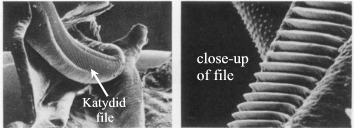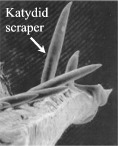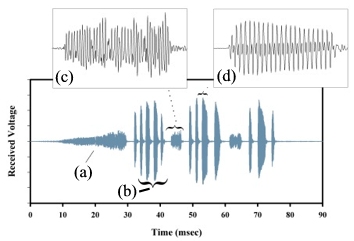home
> products
> BAT's
> BAT
examples
> example A.3.a
Recording the songs of katydids with an air-coupled BAT® detector
Background:
a world rich in
air-coupled ultrasound - Bats, moths, butterflies,
tree frogs,
crickets, cicadas, and katydids are but a few of the many animals known to
rely on the use of air-coupled ultrasound in nature. Bats employ
ultrasonic vision to guide them in the dark and to image potential prey in
flight. Moths, being hunted by bats, return false reflections in an
attempt to confuse the able hunters and avoid being caught. Certain moths,
it is thought, have a form of side-scan sonar which they use to image
their environment to locate approaching bats. Cicadas, high in the
treetops, communicate with ultrasound at long range over forest canopies.
Lower down in the trees are katydids, who use ultrasound to sing songs of
calling and courting to their mates, often unaware that hungry bats are
eavesdropping on their romantic communications. All in all a remarkable
ultrasonic world, and one made more remarkable by the wide array of
biological acoustic systems that have evolved to generate and receive
air-coupled ultrasound (e.g., coupled resonant cavities, ultrasonic waveguides,
mechanical phase-shifters, acoustic horns, and Helmholtz resonators, to
mention only a few).
katydids
- katydids
(or Tettigoniidae) are but one inhabitant of this amazing air-coupled
ultrasonic world. Somewhat like a
cricket, literally thousands of katydid species exist,  leading
to an immense variety in form, size and appearance. In common amongst all
species of katydid are their highly-specialized air-coupled ultrasound
systems. Generation of ultrasound is accomplished by the males only with
the sources of ultrasound located on their backs beneath the wings.
Directional reception of ultrasound occurs in both males and females via
highly complex and little-understood hearing systems which are distributed
throughout the front legs and thorax. Such ultrasonic systems are used in
at least the following three ways: (i) to create "calling songs"
in which males try to attract females; (ii) to create "courtship
songs" when a female has decided upon a male; and (iii) for
"aggression songs" to ward off competition by other males.
leading
to an immense variety in form, size and appearance. In common amongst all
species of katydid are their highly-specialized air-coupled ultrasound
systems. Generation of ultrasound is accomplished by the males only with
the sources of ultrasound located on their backs beneath the wings.
Directional reception of ultrasound occurs in both males and females via
highly complex and little-understood hearing systems which are distributed
throughout the front legs and thorax. Such ultrasonic systems are used in
at least the following three ways: (i) to create "calling songs"
in which males try to attract females; (ii) to create "courtship
songs" when a female has decided upon a male; and (iii) for
"aggression songs" to ward off competition by other males.
 ultrasound
production by katydids - beneath
the two forewings of any male katydid is a scraper and file
structure which the insect uses to generate air-coupled ultrasound.
The scraper is attached to one forewing and the file to the other. By
vibrating the forewings in a certain way, the scraper is drawn back and
forth along the file like a folk-musician playing a washboard,
and high-intensity ultrasound
ultrasound
production by katydids - beneath
the two forewings of any male katydid is a scraper and file
structure which the insect uses to generate air-coupled ultrasound.
The scraper is attached to one forewing and the file to the other. By
vibrating the forewings in a certain way, the scraper is drawn back and
forth along the file like a folk-musician playing a washboard,
and high-intensity ultrasound  is
generated as a result. Typical sound pressure levels generated in this way
(across species) are 70-110db SPL at
5-10cm distances. The shapes of emitted waveforms are as numerous and
diverse as the species themselves, ranging from narrow-band pure
sinusoids, to complex modulated waveforms having 30-40kHz bandwidths and
center frequencies as high as 135kHz. Some of the amazing control features
used by katydids during generation are: (i) changing the rate of scraping
to modulate emitted fundamentals; (ii) adjusting contact forces in
real-time during scraping to provide amplitude modulation; and (iii)
introducing high harmonic content at will by unknown means.
is
generated as a result. Typical sound pressure levels generated in this way
(across species) are 70-110db SPL at
5-10cm distances. The shapes of emitted waveforms are as numerous and
diverse as the species themselves, ranging from narrow-band pure
sinusoids, to complex modulated waveforms having 30-40kHz bandwidths and
center frequencies as high as 135kHz. Some of the amazing control features
used by katydids during generation are: (i) changing the rate of scraping
to modulate emitted fundamentals; (ii) adjusting contact forces in
real-time during scraping to provide amplitude modulation; and (iii)
introducing high harmonic content at will by unknown means.
The experiment:
 MicroAcoustic's
BAT™ transducers can be used to record the calls of insects and
animals that employ air-coupled ultrasound for navigation and communication.
In this example, generation of air-coupled ultrasound by a male katydid was
recorded using a MicroAcoustic BAT™
detector (model BAT-1). The
species of katydid studied was Ancistrocercus.circumdatus (or A.circumdatus),
which measures about 3-4cm in length and has colourings mostly of
cream-yellow & brown with some turquoise green. A typical waveform
received by the BAT™ detector is shown above, and has the
characteristic shape of a male calling song for this katydid species. The waveform
begins with a 20msec long sinusoidal signal at a fundamental frequency of fo
=14kHz, which rises steadily in amplitude before ending abruptly (see
section-a) . Following this are alternating sections of large
amplitude pulse-trains (section-b) and low amplitude sinusoidal
tonebursts (section-c). Three pulse-trains and two tonebursts are
present in total. The number of pulses within a pulse-train decreases as the
song is sung, from 5 to 4 to 3 (left to right). Each individual pulse within
a pulse-train has a very distinct shape (see expanded section-d), in
which a decaying series of alternating highs and lows are purposefully
created by the katydid through additions of significant energy at the
1st-harmonic frequency (i.e., 28kHz). The lower amplitude tonebursts between
pulse-trains always consist of singular bursts of relatively-pure sinusoids
at the fundamental frequency of fo =14kHz (see expanded section-c).
The overall length of the calling song is ~70msec, the envelope of which can
be heard by human ears as a distinct burst of audible "ticks."
MicroAcoustic's
BAT™ transducers can be used to record the calls of insects and
animals that employ air-coupled ultrasound for navigation and communication.
In this example, generation of air-coupled ultrasound by a male katydid was
recorded using a MicroAcoustic BAT™
detector (model BAT-1). The
species of katydid studied was Ancistrocercus.circumdatus (or A.circumdatus),
which measures about 3-4cm in length and has colourings mostly of
cream-yellow & brown with some turquoise green. A typical waveform
received by the BAT™ detector is shown above, and has the
characteristic shape of a male calling song for this katydid species. The waveform
begins with a 20msec long sinusoidal signal at a fundamental frequency of fo
=14kHz, which rises steadily in amplitude before ending abruptly (see
section-a) . Following this are alternating sections of large
amplitude pulse-trains (section-b) and low amplitude sinusoidal
tonebursts (section-c). Three pulse-trains and two tonebursts are
present in total. The number of pulses within a pulse-train decreases as the
song is sung, from 5 to 4 to 3 (left to right). Each individual pulse within
a pulse-train has a very distinct shape (see expanded section-d), in
which a decaying series of alternating highs and lows are purposefully
created by the katydid through additions of significant energy at the
1st-harmonic frequency (i.e., 28kHz). The lower amplitude tonebursts between
pulse-trains always consist of singular bursts of relatively-pure sinusoids
at the fundamental frequency of fo =14kHz (see expanded section-c).
The overall length of the calling song is ~70msec, the envelope of which can
be heard by human ears as a distinct burst of audible "ticks."
Conclusions:
1) This example shows how a MicroAcoustic BAT® detector can be employed to accurately record and study the ultrasonic emissions of katydids. Because emitted sound pressure levels of katydids are similar to those of other insects and bats, the result also proves that BAT® detectors are of general use in the study of animal/insect bio-acoustic emissions.
2) Unlike available microphone technologies which are limited to frequencies below ~135kHz, the MicroAcoustic BAT® detector has a much higher bandwidth (i.e., greater than 2MHz). This means that by employing a BAT® detector instead you will be certain to capture ALL information present in your insect studies and not overlook what may be present (though as yet undiscovered) at higher frequencies.
<< previous example ~ next example >>
www.microacoustic.com